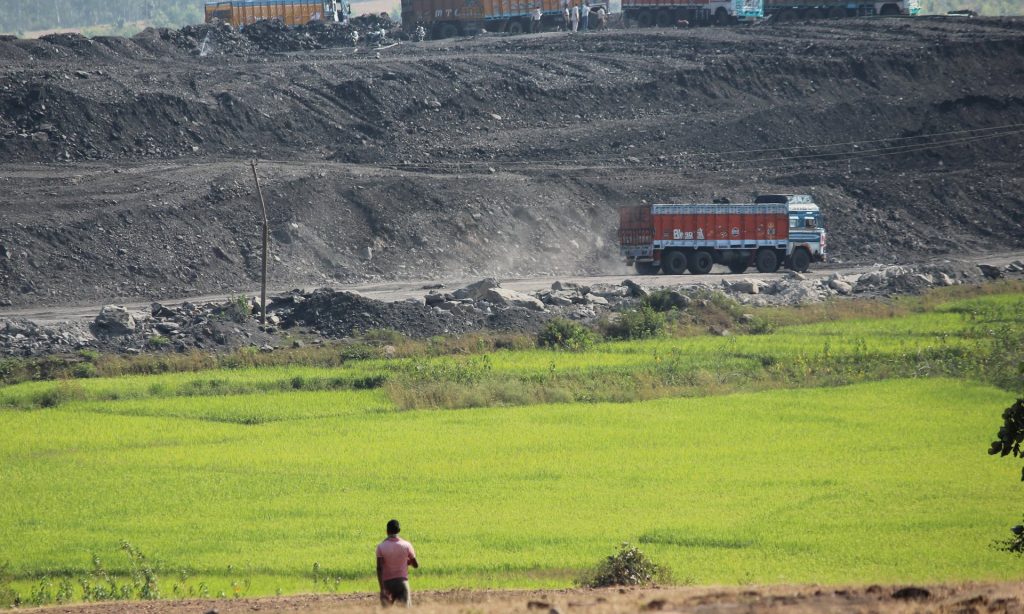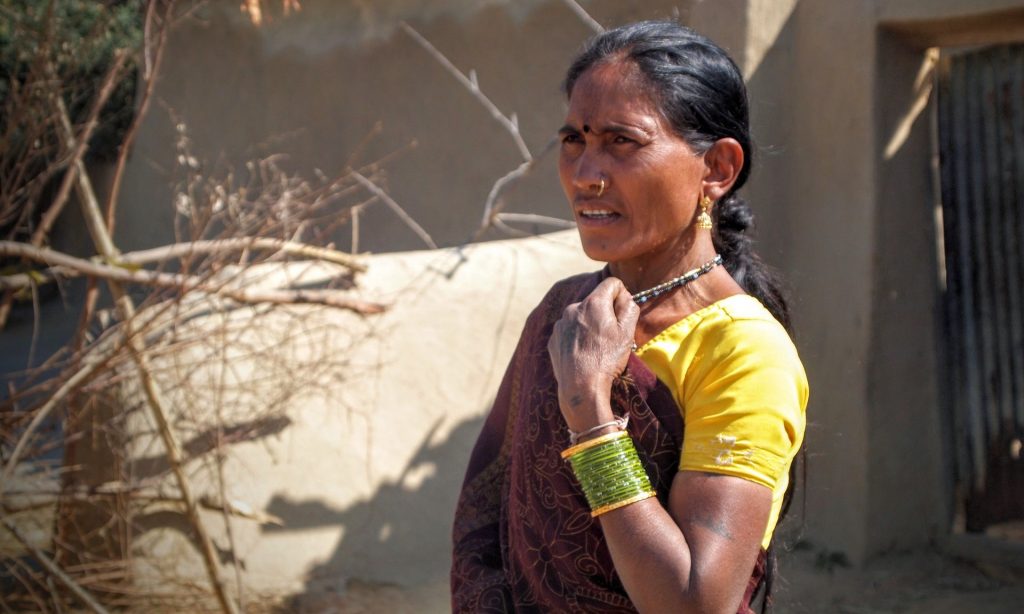
An Adivasi man walks towards his fields on Gair Mazrua common lands, July 2014. Photographs: Amnesty International India
The bulldozer came to Barkuta village at 10am one February morning. Nirupabai was working in the fields when her neighbours called, telling her to rush home. By the time she reached her house it had been reduced to rubble. “I cried, I screamed, trying to save it,” she says, recalling the eviction now two years on. “All my things, my son’s school books, a year’s worth of rice, everything was scattered, everything in ruins.”
Barkuta is one of seven villages that neighbour the Kusmunda opencast coalmine in the state of Chhattisgarh. In 2005, the government drew up an emergency coal production plan to curb the effects of huge, impending energy shortages in the rapidly industrialising country. Kusmunda was one of 16 mines identified for expansion. In 2014, the bulldozers came, and Nirupabai had no home.
According to a report by Amnesty International released on Wednesday, state-owned Coal India and its subsidiaries in the states of Jharkhand, Odisha and Chhattisgarh have neglected both local and international human rights law in the eviction and land acquisition process as mining operations expand. The Ministry of Power has slammed the report as “baseless canards”, which are “part of a conspiracy to derail the development and progress of India”.
The brunt of the coalmine expansion, according to Amnesty, is being borne by India’s Adivasi aboriginal communities. Aruna Chandrashekhar, a researcher at Amnesty, said interviews with 124 people in the three states reveal human rights violations. “Adivasi communities in these areas have been routinely shut out from decision-making processes around their traditional lands, rights and resources.
“Many have had to wait for decades for the compensation and rehabilitation they were promised when their land was acquired. The violations of their rights to consultation and consent – around land acquisition, environmental impacts, indigenous self-governance and the use of traditional lands – has led to serious impacts on their lives and livelihoods,” she said.
Since the evictions, Nirupabai’s family have been living in a hut made from mud and straw. “We don’t have light, water – nothing. Our farm lands have turned black. My son missed his exams because of all this – how is he supposed to study when our whole village, all our lands, have been dug up?” she said.

The government started acquiring land in 1979, and set up a rehabilitation colony 6km away from Barkuta, but a handful of families stayed in their homes, campaigning for jobs in the mines in exchange for their lands, as officials had promised. Over the years, Nirupabai approached the coal company’s headquarters many times, asking for a job, but was turned down for being a woman. “Daughters should donate their land – this is what I was told,” she says in the report.
Others villagers have been forced to move to surrounding villages, claims Amnesty, where they are treated as outsiders. Residents of the rehabilitation colony were never given jobs, nor were they given new lands to farm. They weren’t given proof of residence documents, which means they can’t use their homes as collateral for loans. “Our whole village has been ruined, our lives have been ruined,” said Nirupabai.
Coal is India’s main source of power and successive governments have attempted to expand production. In 2015, India consumed 990 megatonnes of coal, second highest in the world after China. According to PricewaterhouseCoopers, this figure will grow by about 7% every year until 2021.
At this pace of development, India is facing a huge energy crisis. Power cuts are frequent and many companies rely on generators. In 2012, a blackout affected 700 million people across the country: traffic lights stopped working, causing jams in city centres, hospitals had to cancel surgeries, and half-burned bodies were left rotting in electric crematoriums.
Prime minister Narendra Modi’s election campaign promised to revitalise business and prioritise economic development at all costs. Pressure to cut India’s $120bn (£90bn) annual energy import bill means Coal India, already the world’s biggest producer of coal, is under pressure to produce even more.
Laxmi Chauhan, a local human rights and environmental activist from the organisation Sarthak, has seen the villages around the Kusmunda mine being destroyed. “For these people, their land is their identity, it is everything for them. When you take that away, you take their dignity,” he said.
“These villagers are evicted by force, they are beaten until they go; entire villages are emptied out. And they get nothing in return. I have been to villages two or three kilometres away from the coal plants, and they don’t even have electricity. So you may say development, but whose development?”
India’s dependence on coal has come under scrutiny in the past. At the Paris climate summit last year, under pressure to reduce carbon emissions, Modi announced a $30m solar energy plan, but also argued that India should be able to grow using fossil fuels. Modi’s government has always argued that coal is crucial for industrialisation and that per capita consumption is much lower than that of western countries.
The Ministry of Power said it strongly objects to the claims in the report. In a statement, it said: “It is always easy to provide a few stray cases and exaggerate the findings instead of looking at the structural reforms which are sustainably improving the lives of 125 crore [1.25bn] Indians.
“India constitutes 17% of [the] world’s population and is contributing less than 2.5% of greenhouse gas emissions. In fact our coal consumption today is less than what the western countries were consuming 150 years ago,” said a ministry spokesperson.
“The government has dedicated funds for the welfare of local people in mining areas which will generate $1bn annually to support clean water, healthcare, sanitation, education, skills development, women and childcare, welfare of aged and disabled people, environment conservation and sustainable livelihoods. This is an unprecedented step for which no country in the world has ever provided such large sums of money.
“India has embarked on the world’s largest renewable energy programme, a strong message reflecting the commitment of the government to balance development imperatives with concern for the environment.”

